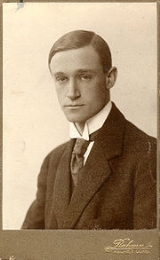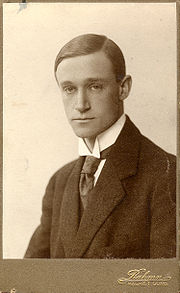
Curt Weibull
Encyclopedia

Sweden
Sweden , officially the Kingdom of Sweden , is a Nordic country on the Scandinavian Peninsula in Northern Europe. Sweden borders with Norway and Finland and is connected to Denmark by a bridge-tunnel across the Öresund....
historian, educator and author.
Biography
Curt Hugo Johannes Weibull was born in LundLund
-Main sights:During the 12th and 13th centuries, when the town was the seat of the archbishop, many churches and monasteries were built. At its peak, Lund had 27 churches, but most of them were demolished as result of the Reformation in 1536. Several medieval buildings remain, including Lund...
, Sweden. He was a member of the noted Swedish Weibull family. He was the son of history professor Martin Weibull (1835-1902) and the brother of Lauritz Weibull
Lauritz Weibull
Lauritz Ulrik Absalon Weibull was a Swedish historian.He was born in Lund, son of history professor Martin Weibull and the brother of Curt Weibull and Carl Gustaf Weibull, enrolled at the University of Lund in 1892, completed his B.A. 1892, his licentiate degree in 1899 and defended his...
, Alexander Weibull, Julius Oscar Elof Weibull and Carl Gustaf Weibull. He and his brothers attended the University of Lund.
Curt Weibull was a professor of history at Gothenburg University
Gothenburg University
The University of Gothenburg is a university in Sweden's second largest city, Gothenburg.- Character :The University of Gothenburg is the third-oldest Swedish university, and with 24,900 full-time students it is also among the largest universities in the Nordic countries...
from 1927–1953 and its president from 1936 to 1946. In 1928 he and his brother, Lauritz Weibull, founded the periodical Scandia. Together they are known for having introduced a critical theory of history in Swedish historical research, inspired by German historian, Leopold von Ranke
Leopold von Ranke
Leopold von Ranke was a German historian, considered one of the founders of modern source-based history. Ranke set the standards for much of later historical writing, introducing such ideas as reliance on primary sources , an emphasis on narrative history and especially international politics .-...
. Weibull was an important mentor to historian Erik Lönnroth
Erik Lönnroth
Erik Lönnroth was one of the most notable Swedish historians of the 20th century. He was a life member of the Swedish Academy from 1962 and member of various faculties.-Background:...
, who further developed the methods to evaluate sources.
His most important and acclaimed work is a criticism regarding the interpretation and the ahistoricism
Ahistoricism
Ahistoricism refers to a lack of concern related to history, historical development, or tradition.Ahistoricism is most frequently used as a criticism, referring to being historically inaccurate or ignorant...
of the Gesta Danorum
Gesta Danorum
Gesta Danorum is a patriotic work of Danish history, by the 12th century author Saxo Grammaticus . It is the most ambitious literary undertaking of medieval Denmark and is an essential source for the nation's early history...
by the 12th century Danish historian Saxo Grammaticus
Saxo Grammaticus
Saxo Grammaticus also known as Saxo cognomine Longus was a Danish historian, thought to have been a secular clerk or secretary to Absalon, Archbishop of Lund, foremost advisor to Valdemar I of Denmark. He is the author of the first full history of Denmark.- Life :The Jutland Chronicle gives...
. This piece was called: Saxo. Kritiska undersökningar i Danmarks historia från Sven Estridsens död till Canute VI (Saxo. Critical studies in Denmark's history from Sven Estriden's death to Canute VI) , and was rather controversial at the time, as it revealed the vague foundations of Denmark
Denmark
Denmark is a Scandinavian country in Northern Europe. The countries of Denmark and Greenland, as well as the Faroe Islands, constitute the Kingdom of Denmark . It is the southernmost of the Nordic countries, southwest of Sweden and south of Norway, and bordered to the south by Germany. Denmark...
's older history of the time.
In 1991, when he was 105, his last work was published: an article in a book celebrating the 100th anniversary of Gothenburg University
Gothenburg University
The University of Gothenburg is a university in Sweden's second largest city, Gothenburg.- Character :The University of Gothenburg is the third-oldest Swedish university, and with 24,900 full-time students it is also among the largest universities in the Nordic countries...
. That probably makes him the oldest historian in the world to have a new study published while still alive. An anecdote tells that when a Danish historian was counter-criticizing parts of Weibull's treatise on Saxo Grammaticus in a doctoral dissertation (believing he was dead since this was after his 100th birthday) Weibull appeared on the public disputation angrily defending his work.
He was the father of the Swedish historian and Liberal politician, Jorgen Weibull (1924-1998) and was buried in Norra kyrkogården in Lund.
Selected works
- Sverige och dess nordiska Grannmakter under den tidigare medeltiden (1921)
- Lübeck och Skånemarknaden. Studier i Lübecks pundtullsböcker och pundtullskvitton 1368-1369 och 1398-1400 (1922)
- Drottning Christina (1931)
- Göteborgs Högskola: dess förhistoria och uppkomst (1941)
- Händelser och utvecklingslinjer. Historiska studier (1949)
- Göta älvs mynning. Land och städer fram i äldre medeltid (1950)
- Tionden i Skåne under senare delen av 1600-talet (1952)
- Die Auswanderung der Goten aus Schweden (1958)
- Källkritik och historia: Norden under äldre medeltiden (1964)
- Die Geaten des Beowulfepos und Die dänischen Trelleburgen : zwei Diskussionsbeiträge (1974)
See also
- Prehistoric SwedenPrehistoric SwedenScandinavian prehistory began when the Scandinavian peninsula, formerly entirely covered by thick ice, became free of ice at the end of the last ice age, around 11,000 BC. At that time, a hunter gatherer people, the Ahrensburg culture, lived and hunted near the edge of the ice...
- Early Swedish historyEarly Swedish historySwedish pre-history ends around 800 CE, when the Viking Age begins and written sources are available. The Viking Age lasted until the mid-11th century, when the Christianization of Scandinavia was largely completed. The period 1050 to 1350 — when the Black Death struck Europe — is considered the...
- Semi-legendary kings of SwedenSemi-legendary kings of SwedenThe semi-legendary kings of Sweden are the long line of Swedish kings who preceded Eric the Victorious, according to sources such as the Norse Sagas, Beowulf, Rimbert, Adam of Bremen and Saxo Grammaticus, but who are of disputed historicity because many of them appear in more or less unreliable...
- a topic closely scrutinized by Curt Weibull
Source
This article is fully or partially based on material from Nordisk familjebokNordisk familjebok
Nordisk familjebok is a Swedish encyclopedia, published between 1876 and 1957.- History :The first edition was published in 20 volumes between 1876 and 1899. The first edition is known as the "Iðunn edition" because of the picture of Iðunn on the cover...
, 1904-1926 and from Nationalencyklopedin
Nationalencyklopedin
Nationalencyklopedin is the most comprehensive contemporary Swedish language encyclopedia, initiated by a favourable loan from the Government of Sweden of 17 million Swedish kronor in 1980, which was repaid by December 1990...
online edition.
Other sources
- Nilsson, Sven A. (1991) Curt Weibull (Årsbok, Yearbook of the Science Society of Lund)

